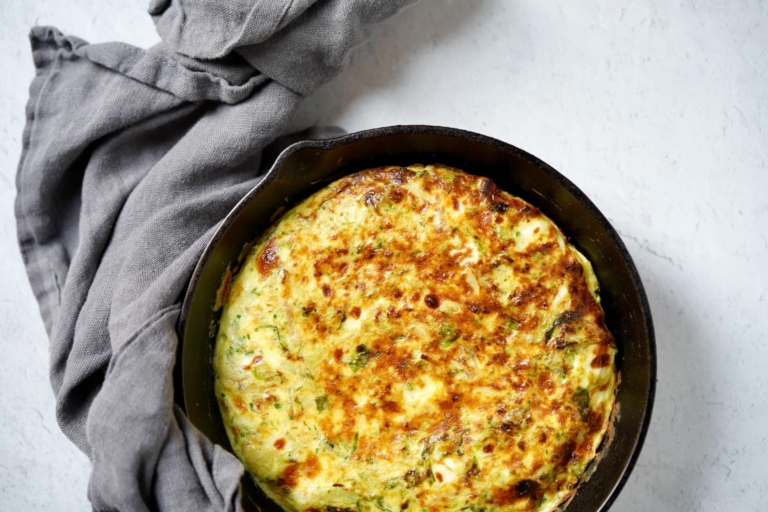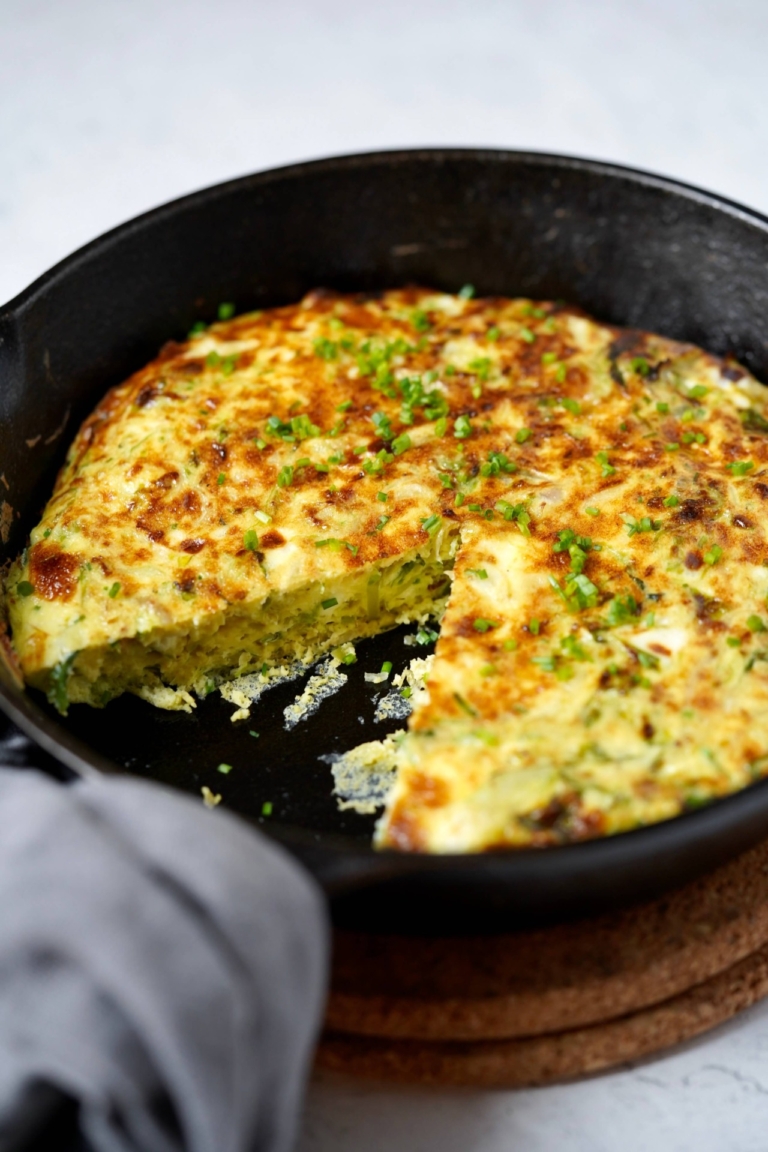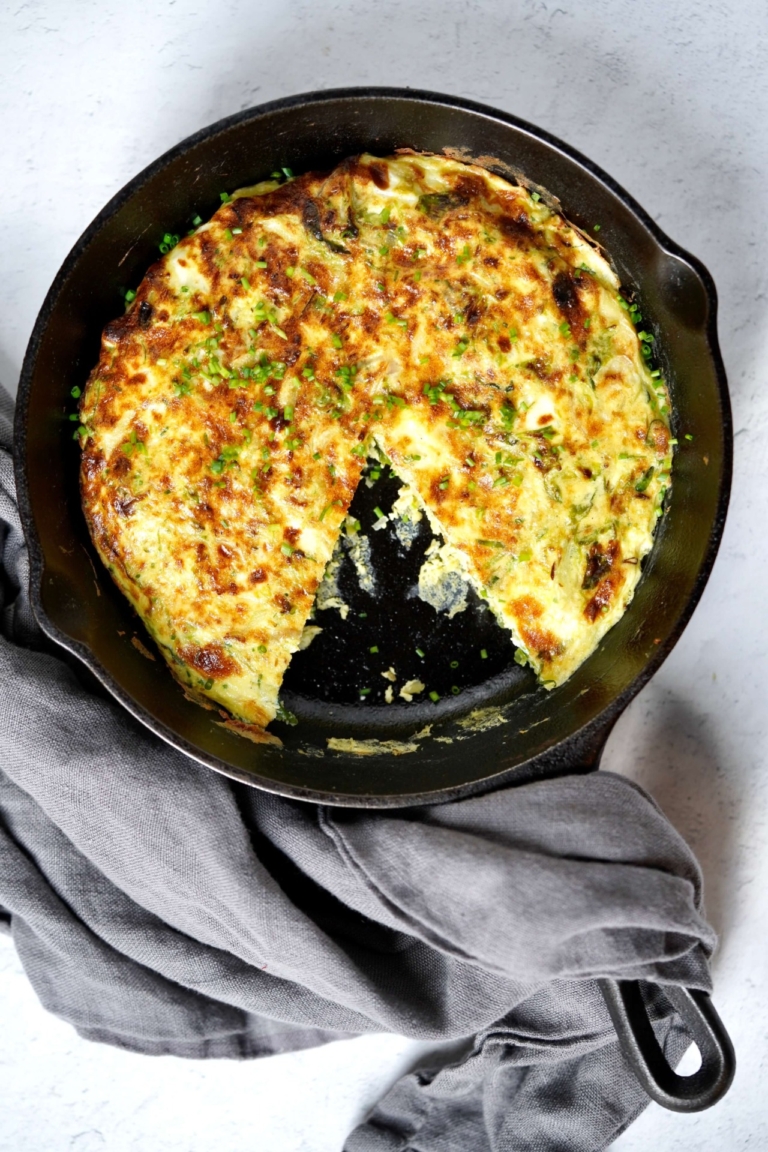Brussels Sprout And Feta Frittata

A shredded Brussels sprout and feta frittata may seem fancy and complicated, but the truth is, it’s not. It’s also the perfect dish for mom if breakfast in bed is on the menu for Mother’s Day. For those unfamiliar, a frittata is an Italian open-faced omelet, often made in a cast iron pan, featuring a variety of ingredients. You can think of frittata as a crustless, low-carb quiche but don’t make the mistake of thinking it’s an omelet because it’s not.
Omelets
There are two types of omelets: a French omelet and an American omelet. And it was not until culinary school that I learned the actual difference.
- French omelets are the most popular variety available throughout Europe. A French omelet is difficult to cook correctly due to the constant stirring motion to cook and set the eggs properly. The ideal French omelet is simply eggs and butter cooked to have a soft and tender texture. The outside should be uniform in color and just hardened enough to stop the inside, slightly loose egg from leaking. Americans sometimes consider French omelets undercooked due to their slightly liquid inside. I have come to prefer it. Getting the proper French omelet texture was one of the most difficult things to master in culinary school. But I was fortunate to have been taught by master chefs, Jacques Pépin and André Soltner. If you’re interested in mastering this classic technique yourself, check out this link.
- American omelets are simple to make and often defined by their ability to host a variety of fillings. Unlike the French omelet, there is no “perfect” American omelet; however, some basics like shape and texture tend to be universal. In comparison, an American omelet is substantially easier to make than a French one. American omelets require less movement and advanced techniques and are fairly difficult to overcook since they lack a loose center.
Frittatas
A frittata is an egg dish that can be served for breakfast, lunch, or dinner; tastes as good room temperature as it does warm; and can be packed with just about anything. Unlike an omelet’s filling (which is rolled or just sprinkled on top of the egg) the frittata’s ingredients typically get mixed in with the egg and milk before cooking. The frittata can be cooked either in the oven or on the stovetop, but no matter which method is used it is almost always placed under the broiler to be finished off.
The Differences
In the strictest sense, the difference between the omelet and the frittata boils down to a matter of folding the cooked egg around the filling versus mixing the filling into the raw egg mixture. But there are a few other distinctions as well.
- Both sides of the frittata get cooked while just the underside of the omelet touches the pan.
- A frittata is cooked slowly over low heat while an omelet is cooked quickly over higher heat.
- Omelets are served hot straight from the stove, frittatas can be served hot or at room temperature.
In my Brussels sprout and feta frittata, I stray from the traditional frittata-making method and don’t incorporate all the ingredients into the egg and milk mixture. In this recipe, I simplify the method by reducing steps. I prefer to sauté the shallots and spouts beforehand. I like to finish my frittata in the broiler to obtain some nice coloration on top. Frittatas are an easy breakfast that is often overlooked but deserves rediscovery as they are simpler than either version of omelets and can serve more than one at a time.
Brussels Sprout And Feta Frittata
Ingredients:
- 2 tablespoons Extra Virgin olive oil
- 2 shallots, halved and thinly sliced
- 3/4 pound Brussels sprouts, thinly shaved
- Kosher salt
- Freshly ground black pepper
- 8 large whole eggs
- 3 tablespoons whole milk
- 1 cup feta cheese, crumbled
- 1/4 cup chives, finely chopped
Directions:
- Preheat the broiler and position a rack 6 inches from the heat.
- Place a 12-inch cast iron or nonstick ovenproof skillet, over medium-high heat. Add the oil and when hot, but not smoking, add the shallots and shredded sprouts, cook, stirring occasionally, until softened, 5 minutes. Season with salt and pepper and cook, tossing occasionally, until crisp-tender and lightly browned, about 3 more minutes.
- Meanwhile, in a large bowl, beat the eggs with the milk, 1 teaspoon of salt, and 1/4 teaspoon of pepper. Add the feta cheese and chives, and mix well. Pour the egg mixture into the skillet and cook over moderate heat, stirring gently, until the eggs start to set about 5 minutes.
- Place the skillet in the oven and broil for about 3 minutes, until the center is set. Run a rubber spatula around the edge of the frittata and slide it onto a serving plate. Cut to serve.





We did this – mad tasty…also…You want the boiled ‘Brussels sprouts with nam-plah’ recipe from Gabrielle Hamilton/NYT — yes, you do. Everybody does.
You made me laugh. Love it. Happy Holidays!